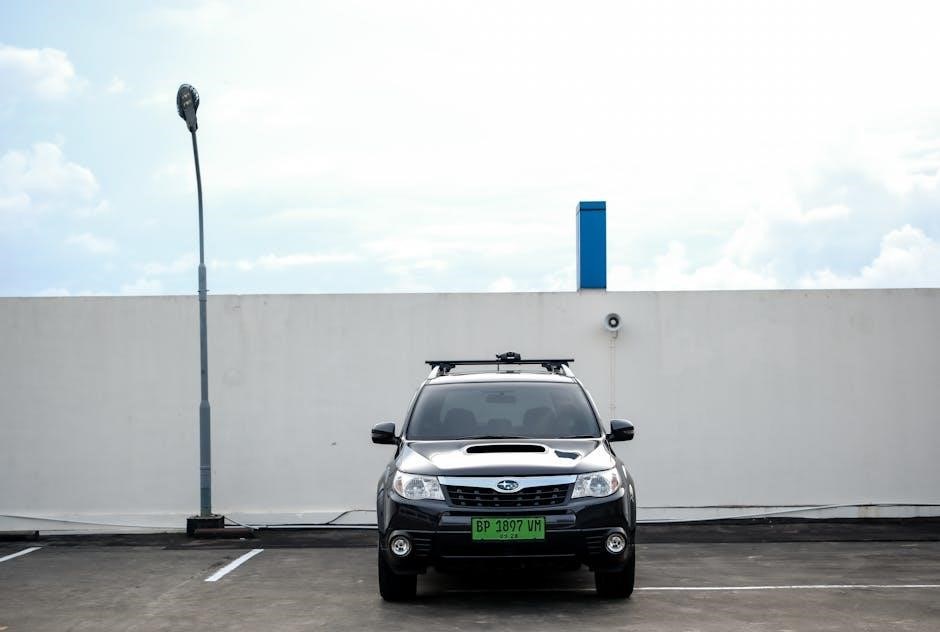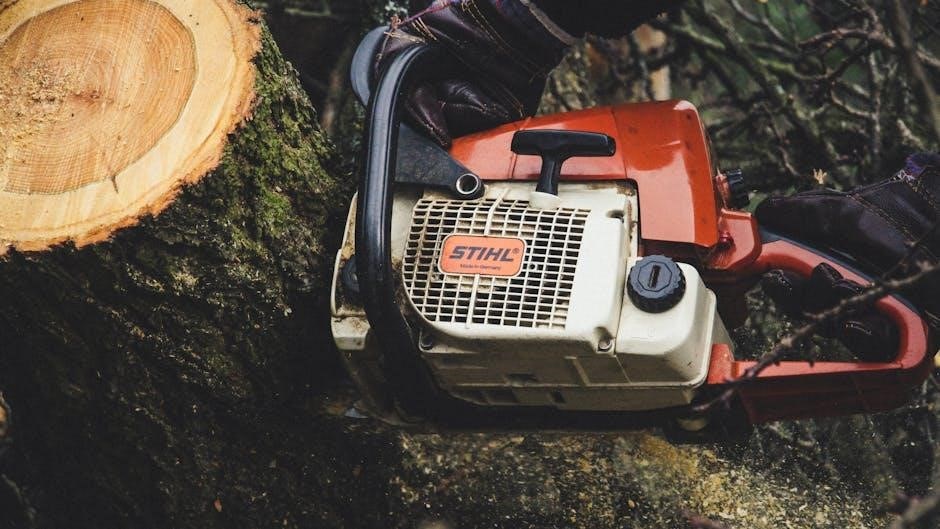2022 subaru forester maintenance schedule pdf
The 2022 Subaru Forester maintenance schedule is essential for ensuring optimal performance and longevity. Regular checks at 7,500, 15,000, and 30,000 miles are crucial for extending lifespan. Access the detailed PDF schedule on Subaru’s official website or owner’s portal for tailored service recommendations.
1.1 Importance of Regular Maintenance for the Subaru Forester
Regular maintenance is crucial for the Subaru Forester to ensure optimal performance, reliability, and longevity. It helps prevent mechanical issues, reduces repair costs, and maintains fuel efficiency. Following the recommended schedule ensures all components function properly, enhancing safety and overall driving experience. Proper upkeep also preserves the vehicle’s value and warranty. Refer to the 2022 Subaru Forester maintenance schedule PDF for detailed guidelines tailored to your vehicle’s needs.
1.2 Overview of the 2022 Subaru Forester Maintenance Schedule
The 2022 Subaru Forester maintenance schedule is structured to ensure timely servicing at key intervals: 7,500, 15,000, and 30,000 miles. It includes oil changes, tire pressure checks, and inspections of essential systems like brakes and belts. The schedule is designed to address specific needs at each milestone, ensuring reliability and performance. The detailed PDF, available on Subaru’s official website or owner’s portal, outlines these services for easy reference and compliance.
Key Service Intervals for the 2022 Subaru Forester
Regular servicing at 7,500, 15,000, and 30,000 miles is critical for maintaining the Subaru Forester. These intervals ensure essential checks and replacements are performed promptly.
2.1 Maintenance Schedule at 7,500 Miles
The 7,500-mile service is the first major checkpoint for the 2022 Subaru Forester. It includes an oil and filter change, tire pressure checks, and inspections of key components like brakes and belts. This interval ensures early detection of potential issues, maintaining the vehicle’s reliability and performance. Adhering to this schedule helps prevent costly repairs and keeps your Forester running smoothly.
2.2 Maintenance Schedule at 15,000 Miles
At 15,000 miles, the 2022 Subaru Forester requires a more comprehensive service. This includes an emissions tune-up, replacement of the engine oil and filter, and a thorough inspection of the vehicle’s systems. Tires are rotated, and all fluid levels are checked and topped off. Additionally, the air filter is inspected, and the brake system is evaluated for wear. This milestone ensures the Forester continues to perform efficiently and reliably.
2.3 Maintenance Schedule at 30,000 Miles
At 30,000 miles, the 2022 Subaru Forester’s maintenance includes a detailed inspection of belts, hoses, and the exhaust system. The engine air filter and cabin air filter are replaced, and the battery is tested for performance and charge levels. Brake pads are inspected for wear, and the transmission fluid is checked. This service ensures all components are in optimal condition, preventing potential issues and maintaining the vehicle’s reliability and performance over time.

Schedule A: Standard Maintenance Services
Schedule A outlines 25 essential maintenance items for the 2022 Subaru Forester, including inspections and replacements, ensuring the vehicle operates efficiently and maintains its longevity.
3.1 List of 25 Maintenance Items for Schedule A
Schedule A for the 2022 Subaru Forester includes 25 maintenance items, such as engine oil and filter replacement, tire pressure checks, air filter inspections, and battery tests. It also covers brake pad inspections, belt and hose checks, and fluid level evaluations. These services are designed to ensure the vehicle operates efficiently and prevent potential issues. Refer to the official Subaru Forester maintenance schedule PDF for the complete list of items and guidelines.
3.2 Inspection and Replacement Guidelines
The 2022 Subaru Forester maintenance schedule includes detailed inspection and replacement guidelines for components like belts, hoses, and fluids. Inspections are performed at specific intervals to identify wear or damage. Replacement criteria are based on condition, mileage, or time. For example, the timing belt is typically replaced at 105,000 miles, while brake pads are replaced when thickness falls below 1/8 of an inch. Always refer to the official Subaru Forester maintenance schedule PDF for precise guidelines.
Schedule B: Additional Maintenance Requirements
Schedule B outlines extra services for high-mileage or extreme condition use, including transmission and differential fluid inspections, spark plug replacement, and PCV valve checks.
4.1 Services Beyond the Standard Schedule
Beyond the standard schedule, services include transmission and differential fluid inspections, spark plug replacement, and PCV valve checks. These are recommended for high-mileage vehicles or those driven in extreme conditions. Additionally, drive belts should be inspected for cracks or wear. These services ensure optimal performance and prevent unexpected repairs. Regularly checking these components helps maintain the vehicle’s reliability and longevity, especially under demanding driving conditions.
4.2 Special Recommendations for High-Mileage Vehicles
For high-mileage vehicles, additional inspections are recommended, including transmission and differential fluid checks; Spark plugs should be replaced every 30,000 miles, and the PCV valve should be inspected. Drive belts and hoses should also be checked for signs of wear. These measures help maintain performance and prevent costly repairs. Vehicles driven in extreme conditions may require more frequent servicing to ensure reliability and longevity.

Oil Change and Filter Replacement
Regular oil changes are essential for the 2022 Subaru Forester. Change the oil every 7,500 miles or 12,000 km using 0W-20 synthetic oil. Replace the oil filter each time. Check the cabin air filter and tire pressure during service for optimal performance.
5.1 Recommended Oil Type and Filter for the Subaru Forester
The 2022 Subaru Forester requires 0W-20 synthetic oil for optimal performance in all temperatures. Use a high-quality oil filter designed for your vehicle to ensure proper engine protection. Synthetic oil is recommended for its superior lubrication and fuel efficiency. Always refer to the owner’s manual for specific guidelines on oil and filter replacements to maintain your Subaru’s longevity and performance. Proper filtration and oil viscosity are crucial for engine health.
5.2 Frequency of Oil Changes
The 2022 Subaru Forester recommends oil changes every 6,000 miles or 1 year, whichever comes first. Regular oil changes ensure engine longevity and optimal performance. Synthetic oil is preferred for its superior lubrication and fuel efficiency. Adhering to this schedule helps maintain your vehicle’s health and prevents premature wear. Always consult the owner’s manual for specific recommendations tailored to your driving conditions and mileage.
Tire Maintenance and Rotation
Regular tire pressure checks and rotations every 6 months or 6,000 miles are essential for optimal performance and even tread wear in the Subaru Forester.
6.1 Tire Pressure Adjustment and Inspection
Check tire pressure monthly and before long trips, ensuring proper inflation as per the owner’s manual. Inspect tires for uneven wear, punctures, or damage. Rotate tires every 6,000 miles for even tread wear. Refer to the 2022 Subaru Forester maintenance schedule PDF for specific guidelines and recommendations to maintain optimal tire performance and safety.
6.2 Recommended Tire Rotation Pattern
For the 2022 Subaru Forester, tires should be rotated every 6,000 miles or 6 months. Use a rearward cross pattern for Symmetrical AWD vehicles; Move the front tires to the rear on the opposite side, and the rear tires to the front on the same side. This ensures even tread wear and maintains optimal performance. Refer to the maintenance schedule PDF for detailed diagrams and instructions.
Cabin Air Filter and Engine Air Filter
The cabin air filter should be replaced every 15,000 to 30,000 miles to maintain air quality. The engine air filter should be replaced every 15,000 to 30,000 miles for optimal performance.
7.1 Replacement Interval for the Cabin Air Filter
The cabin air filter in the 2022 Subaru Forester should be replaced every 15,000 to 30,000 miles to ensure clean air circulation. Regular replacement helps eliminate odors, allergens, and dust, improving interior comfort. Refer to the official maintenance schedule PDF for specific guidelines tailored to your vehicle’s needs.
7.2 Importance of the Engine Air Filter
The engine air filter is crucial for the 2022 Subaru Forester’s performance. It ensures clean air intake, enhancing fuel efficiency and engine power. A dirty filter can lower mileage and damage components. The 2022 Subaru Forester maintenance schedule PDF recommends replacing it every 15,000 to 30,000 miles to maintain optimal engine health and performance.

Battery Maintenance and Inspection
Regular battery checks ensure reliable starting and electrical system performance. Inspect terminals for corrosion and secure connections. Replace the battery every 7,500 miles or as needed.
8.1 Signs of Battery Wear
Recognizing battery wear is crucial for preventing unexpected failures. Signs include slow engine crank, dim or flickering lights, and difficulty starting the vehicle. Corrosion on terminals and swelling of the battery case are additional indicators. If these symptoms appear, schedule a professional inspection promptly to ensure your Subaru Forester’s electrical system remains reliable and efficient.
8.2 Recommended Battery Check Intervals
Subaru recommends checking the battery every 6 months or at the 15,000-mile mark to ensure optimal performance. Inspections should include testing the battery’s charge level, checking terminals for corrosion, and ensuring secure connections. Refer to the 2022 Subaru Forester maintenance schedule PDF for detailed guidelines. Regular checks help prevent unexpected failures and ensure reliable starting power for your vehicle.
Brake Pad Inspection and Replacement
Brake pads should be inspected every 15,000 miles and replaced when thickness falls below 1/8″. Grinding noises or vibrations indicate replacement is necessary for safe braking performance.
9.1 Brake Pad Thickness Guidelines
The 2022 Subaru Forester requires brake pads to be inspected regularly. Pads should be replaced when thickness falls below 1/8″. Subaru recommends checking every 15,000 miles. Worn pads can cause grinding noises or vibrations. Proper thickness ensures safe braking performance and prevents rotor damage. Always refer to the official PDF schedule for detailed guidelines and recommendations to maintain optimal brake function and safety on the road.
9.2 Signs of Worn Brake Pads
Worn brake pads on the 2022 Subaru Forester may exhibit squealing noises during braking, a spongy brake pedal, or vibrations when slowing down. If the vehicle pulls to one side while braking, it indicates uneven wear; Inspect pads regularly, as excessive wear can damage rotors. Refer to the maintenance schedule PDF for guidelines on identifying and addressing worn pads to ensure safe braking performance and prevent costly repairs.

Belts and Hoses Inspection
Inspect belts for cracks, frays, or wear; replace if damaged. Check hoses for leaks or softening. Regular checks prevent engine damage and ensure reliable performance.
10.1 Timing Belt and Serpentine Belt Inspection
The timing belt and serpentine belt should be inspected every 30,000 miles. Check for cracks, frays, or excessive wear. Replace the timing belt by 105,000 miles to prevent engine damage. The serpentine belt powers essential systems, so regular checks ensure reliability. Follow the 2022 Subaru Forester maintenance schedule for precise intervals and procedures to maintain optimal vehicle performance and avoid costly repairs.
10.2 Signs of Worn Hoses
Inspect hoses for cracks, frays, or leaks. Look for soft spots, brittleness, or discoloration. Coolant hoses may show signs of swelling or deterioration near connections. If hoses are damaged, replace them promptly to prevent fluid leaks and engine damage. Regular inspections, as outlined in the 2022 Subaru Forester maintenance schedule, help identify wear early, ensuring reliable performance and avoiding costly repairs.
Fluid Checks and Replenishment
Regularly inspect engine oil, coolant, transmission, and brake fluids. Check levels and condition at every 7,500 to 15,000 miles. Top off as needed to ensure proper vehicle function and prevent damage.
11.1 Types of Fluids to Check
Regularly inspect the engine oil, coolant, transmission fluid, and brake fluid levels. Additionally, check the power steering fluid and windshield washer fluid. Ensure all fluids are at recommended levels and free from contamination. Engine oil and transmission fluid are critical for lubrication, while coolant prevents overheating. Brake fluid is essential for safe stopping power. Refer to the 2022 Subaru Forester maintenance schedule PDF for specific guidelines on each fluid type.
11.2 Recommended Fluid Levels
Maintain engine oil levels between the minimum and maximum marks on the dipstick. Coolant should be filled to the recommended level indicated on the reservoir. Transmission fluid levels should align with the “FULL” mark when warm. Brake fluid should remain at the designated level without dropping below the minimum line. Power steering fluid should be checked and topped off as needed. Always consult the 2022 Subaru Forester maintenance schedule PDF for precise fluid level specifications and guidelines.
Wiper Blades and Exterior Lights
Inspect and replace wiper blades every 6 months or when showing signs of wear. Check exterior lights for cleanliness and proper function to ensure visibility and safety.
12.1 Wiper Blade Replacement Interval
Subaru recommends replacing wiper blades every 6 months or when signs of wear appear. Check for cracks, uneven wiping, or noise. Ensure proper visibility and safety by replacing blades as needed. Clean blades regularly and inspect for damage. Always use Subaru-approved blades for optimal performance. Refer to the maintenance schedule PDF for detailed guidelines on wiper blade care and replacement.
12.2 Inspection of Exterior Lights
Inspect exterior lights every 6 months or when a bulb fails. Check headlights, taillights, brake lights, and turn signals. Replace any damaged or dim bulbs promptly. Clean lenses to maintain visibility and avoid moisture buildup. Ensure all lights function correctly for safety and compliance with regulations. Refer to the Subaru Forester maintenance schedule PDF for detailed inspection steps and replacement guidelines.
Exhaust System Inspection
Inspect the exhaust system annually or when symptoms like decreased performance or unusual noises occur. Check for leaks, damage, or rust. Ensure proper functionality to maintain performance and reduce emissions. Regular inspections help prevent costly repairs and ensure safe operation.
13.1 Importance of Exhaust System Maintenance
Regular exhaust system maintenance is crucial for the 2022 Subaru Forester. It ensures optimal engine performance, reduces harmful emissions, and prevents costly repairs. A well-maintained exhaust system improves fuel efficiency and minimizes noise. Neglecting it can lead to decreased vehicle performance and potential safety hazards. Schedule inspections annually or when symptoms arise to maintain your Subaru’s reliability and environmental compliance. Regular checks ensure longevity and prevent unexpected breakdowns.
13.2 Signs of Exhaust System Issues
Common signs of exhaust system issues in the 2022 Subaru Forester include loud engine noises, decreased fuel efficiency, and reduced vehicle performance. Drivers may notice a decrease in power output or a noticeable vibration. A bright dashboard warning light or a strong, unpleasant odor from the exhaust are also indicators. Addressing these signs promptly prevents further damage and ensures safe, efficient vehicle operation. Regular inspections help identify potential problems early.
Spark Plug Replacement
Spark plug replacement is crucial for maintaining the 2022 Subaru Forester’s performance and efficiency. Subaru recommends replacing spark plugs at specified intervals to avoid engine damage and ensure optimal function. Regular checks and timely replacements are detailed in the maintenance schedule PDF for proper upkeep.
14.1 Recommended Spark Plug Replacement Interval
For the 2022 Subaru Forester, spark plugs should be replaced at 30,000 miles and again at 105,000 miles to ensure optimal engine performance. Following Subaru’s recommended intervals helps maintain efficiency and prevent potential damage. Refer to the official maintenance schedule PDF for detailed guidelines and specifications to keep your vehicle running smoothly.
14.2 Signs of Worn Spark Plugs
Signs of worn spark plugs in the 2022 Subaru Forester include decreased fuel efficiency, rough engine idling, and misfires. If you notice difficulty starting the engine or a noticeable decrease in performance, it may indicate worn spark plugs. Addressing these issues promptly is crucial to avoid further damage. Refer to the maintenance schedule PDF for specific guidelines on diagnosing and replacing spark plugs effectively.

Accessing the 2022 Subaru Forester Maintenance Schedule PDF
Download the official 2022 Subaru Forester maintenance schedule PDF from Subaru’s website or owner’s portal. This comprehensive guide provides detailed service intervals and recommendations for optimal vehicle care.
15.1 Downloading the PDF from Subaru’s Official Website
Visit Subaru’s official website and navigate to the Owner’s Resources section. Select your vehicle model and year to access the 2022 Subaru Forester maintenance schedule PDF. Click the download link to save the document, ensuring you have Adobe Acrobat Reader for viewing. This PDF provides detailed maintenance intervals, service recommendations, and guidelines to keep your Forester in top condition. Regularly refer to it for proactive car care.
15.2 Navigating the Subaru Owner’s Portal
Log in to the Subaru Owner’s Portal using your email and password. Once logged in, navigate to the Vehicle Resources section. Select your 2022 Subaru Forester to access maintenance schedules, owner’s manuals, and service history. Click on the Maintenance Schedule tab to view or download the PDF directly. This portal also provides additional resources, such as tips for maintaining your vehicle and tracking service appointments, ensuring your Forester stays well-maintained.
Adhering to the 2022 Subaru Forester maintenance schedule ensures optimal performance, longevity, and safety. Regular checks and timely replacements guarantee a smooth driving experience for years to come.
16.1 Summary of Key Maintenance Points
Regular maintenance is vital for the 2022 Subaru Forester’s performance and longevity; Key points include oil changes every 7,500 miles, tire rotations, and cabin air filter replacements. Brake pads, belts, and hoses should be inspected at recommended intervals. Fluid checks, wiper blade replacements, and exhaust system inspections are also essential. Refer to the official Subaru Forester maintenance schedule PDF for detailed guidance on ensuring your vehicle runs smoothly and efficiently over time.
16.2 Final Tips for Maintaining Your Subaru Forester
Proactive maintenance ensures your Subaru Forester remains reliable and efficient. Always refer to the official maintenance schedule PDF for specific guidelines. Keep track of service intervals and address issues promptly. Regular inspections and timely replacements prevent costly repairs. Maintain a clean environment and monitor fluid levels. By following Subaru’s recommendations, you’ll enjoy a smooth driving experience and extend your vehicle’s lifespan. Consistency is key to preserving performance and safety.


